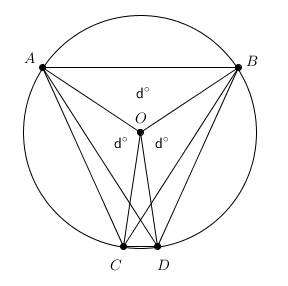Difference between revisions of "2001 AIME I Problems/Problem 13"
(→Solution) |
m (→Solution) |
||
| Line 15: | Line 15: | ||
We can then apply the quadratic formula to find the positive root to this equation since polygons obviously cannot have sides of negative length. | We can then apply the quadratic formula to find the positive root to this equation since polygons obviously cannot have sides of negative length. | ||
| − | <cmath>x = | + | <cmath>x = \frac{-18 + \sqrt{18^2 + 4(84)}}{2}</cmath> |
| − | <cmath>x = | + | <cmath>x = \frac{-18 + \sqrt{660}}{2}</cmath> |
<math>x</math> simplifies to <math>\frac{-18 + 2\sqrt{165}}{2},</math> which equals <math>-9 + \sqrt{165}.</math> Thus, the answer is <math>9 + 165 = \boxed{174}</math>. | <math>x</math> simplifies to <math>\frac{-18 + 2\sqrt{165}}{2},</math> which equals <math>-9 + \sqrt{165}.</math> Thus, the answer is <math>9 + 165 = \boxed{174}</math>. | ||
Revision as of 10:28, 12 March 2015
Problem
In a certain circle, the chord of a ![]() -degree arc is
-degree arc is ![]() centimeters long, and the chord of a
centimeters long, and the chord of a ![]() -degree arc is
-degree arc is ![]() centimeters longer than the chord of a
centimeters longer than the chord of a ![]() -degree arc, where
-degree arc, where ![]() The length of the chord of a
The length of the chord of a ![]() -degree arc is
-degree arc is ![]() centimeters, where
centimeters, where ![]() and
and ![]() are positive integers. Find
are positive integers. Find ![]()
Solution

Note that a cyclic quadrilateral in the form of an isosceles trapezoid can be formed from three chords of three ![]() -degree arcs and one chord of one
-degree arcs and one chord of one ![]() -degree arc. The diagonals of this trapezoid turn out to be two chords of two
-degree arc. The diagonals of this trapezoid turn out to be two chords of two ![]() -degree arcs. Let
-degree arcs. Let ![]() ,
, ![]() , and
, and ![]() be the chords of the
be the chords of the ![]() -degree arcs, and let
-degree arcs, and let ![]() be the chord of the
be the chord of the ![]() -degree arc. Also let
-degree arc. Also let ![]() be equal to the chord length of the
be equal to the chord length of the ![]() -degree arc. Hence, the length of the chords,
-degree arc. Hence, the length of the chords, ![]() and
and ![]() , of the
, of the ![]() -degree arcs can be represented as
-degree arcs can be represented as ![]() , as given in the problem.
, as given in the problem.
Using Ptolemy's theorem,
![]()
![]()
![]()
![]()
We can then apply the quadratic formula to find the positive root to this equation since polygons obviously cannot have sides of negative length.
![]()
![]()
![]() simplifies to
simplifies to ![]() which equals
which equals ![]() Thus, the answer is
Thus, the answer is ![]() .
.
See also
| 2001 AIME I (Problems • Answer Key • Resources) | ||
| Preceded by Problem 12 |
Followed by Problem 14 | |
| 1 • 2 • 3 • 4 • 5 • 6 • 7 • 8 • 9 • 10 • 11 • 12 • 13 • 14 • 15 | ||
| All AIME Problems and Solutions | ||
The problems on this page are copyrighted by the Mathematical Association of America's American Mathematics Competitions. 









